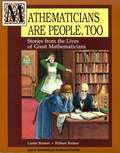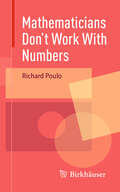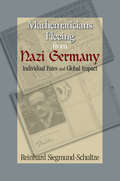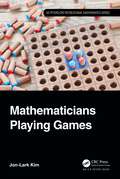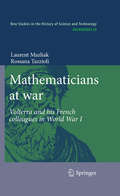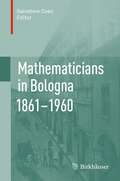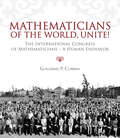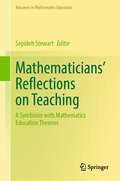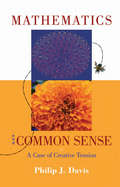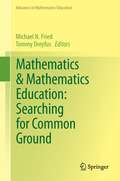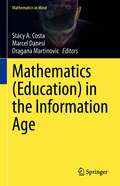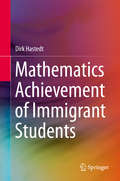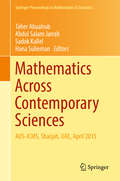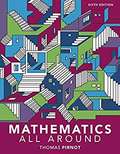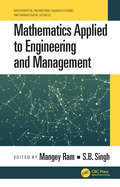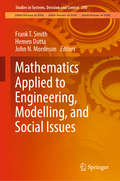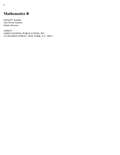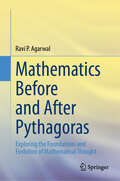- Table View
- List View
Mathematicians Are People, Too: Stories From The Lives Of Great Mathematicians (Volume One)
by Luetta Reimer Wilbert ReimerVolume One focuses on moments of mathematical discovery experienced by Thales, Pythagoras, Hypatia, Galileo, Pascal, and others.
Mathematicians Don't Work With Numbers
by Richard PouloThis book answers, in the form of short and entertaining vignettes, the question: "What do mathematicians really do?" Readers will learn that mathematicians use numbers in the same way that novelists use letters. The individual letters are typed while the author thinks on a much grander scale, invisible to the observer. Requiring only familiarity with the multiplication table (and that for only one vignette), the book makes accessible a variety of mathematical concepts, such as game theory, chaos, and traffic flow modelling. The author accomplishes this with a light, engaging style, and a range of real-world examples that includes everything from barbershops to President James Garfield. Mathematicians Don't Work With Numbers will be of interest to the large audience of people who have always assumed that mathematicians do, in fact, work with numbers.
Mathematicians Fleeing from Nazi Germany: Individual Fates and Global Impact
by Reinhard Siegmund-SchultzeThe emigration of mathematicians from Europe during the Nazi era signaled an irrevocable and important historical shift for the international mathematics world. Mathematicians Fleeing from Nazi Germany is the first thoroughly documented account of this exodus. In this greatly expanded translation of the 1998 German edition, Reinhard Siegmund-Schultze describes the flight of more than 140 mathematicians, their reasons for leaving, the political and economic issues involved, the reception of these emigrants by various countries, and the emigrants' continuing contributions to mathematics. The influx of these brilliant thinkers to other nations profoundly reconfigured the mathematics world and vaulted the United States into a new leadership role in mathematics research. Based on archival sources that have never been examined before, the book discusses the preeminent emigrant mathematicians of the period, including Emmy Noether, John von Neumann, Hermann Weyl, and many others. The author explores the mechanisms of the expulsion of mathematicians from Germany, the emigrants' acculturation to their new host countries, and the fates of those mathematicians forced to stay behind. The book reveals the alienation and solidarity of the emigrants, and investigates the global development of mathematics as a consequence of their radical migration. An in-depth yet accessible look at mathematics both as a scientific enterprise and human endeavor, Mathematicians Fleeing from Nazi Germany provides a vivid picture of a critical chapter in the history of international science.
Mathematicians Playing Games (AK Peters/CRC Recreational Mathematics Series)
by Jon-Lark KimMathematicians Playing Games explores a wide variety of popular mathematical games, including their historical beginnings and the mathematical theories that underpin them. Its academic level is suitable for high school students and higher, but people of any age or level will find something to entertain them, and something new to learn. It would be a fantastic resource for high school mathematics classrooms or undergraduate mathematics for liberal arts course and belongs on the shelf of anyone with an interest in recreational mathematics. Features Suitable for anyone with an interest in games and mathematics, and could be especially useful to middle and high school students and their teachers Includes various exercises for fun for readers
Mathematicians at war
by Laurent Mazliak Rossana TazzioliNumerous scientists have taken part in the war effort during World War I, but few gave it the passionate energy of the prominent Italian mathematician Volterra. As a convinced supporter of the cause of Britain and France, he struggled vigorously to carry Italy into the war in May 1915 and then developed a frenetic activity to support the war effort, going himself to the front, even though he was 55. This activity found an adequate echo with his French colleagues Borel, Hadamard and Picard. The huge correspondence they exchanged during the war, gives an extraordinary view of these activities, and raises numerous fundamental questions about the role of a scientist, and particularly a mathematician during WW I. It also offers a vivid documentation about the intellectual life of the time ; Volterra's and Borel's circles in particular were extremely wide and the range of their interests was not limited to their field of specialization. The book proposes the complete transcription of the aforementioned correspondence, annotated with numerous footnotes to give details on the contents. It also offers a general historical introduction to the context of the letters and several complements on themes related to the academic exchanges between France and Italy during the war.
Mathematicians in Bologna 1861–1960
by Salvatore CoenThe scientific personalities of Luigi Cremona, Eugenio Beltrami, Salvatore Pincherle, Federigo Enriques, Beppo Levi, Giuseppe Vitali, Beniamino Segre and of several other mathematicians who worked in Bologna in the century 1861-1960 are examined by different authors, in some cases providing different view points. Most contributions in the volume are historical; they are reproductions of original documents or studies on an original work and its impact on later research. The achievements of other mathematicians are investigated for their present-day importance.
Mathematicians of the World, Unite!: The International Congress of Mathematicians--A Human Endeavor
by Guillermo CurberaThis vividly illustrated history of the International Congress of Mathematicians- a meeting of mathematicians from around the world held roughly every four years- acts as a visual history of the 25 congresses held between 1897 and 2006, as well as a story of changes in the culture of mathematics over the past century. Because the congress is an int
Mathematicians' Reflections on Teaching: A Symbiosis with Mathematics Education Theories (Advances in Mathematics Education)
by Sepideh StewartThis book opens the case on collaboration among mathematicians and mathematics educators. The authors of this book provide their research and experience based insights on collaboration to inspire the young generation of the mathematics community to engage in productive collaborations and exchange of knowledge early in their careers. These valuable collaborations are anticipated to generate innovative research questions that set new and novel paths for mathematics education research with ample possibilities yet to be realized and discovered.
Mathematics
by David J. Chard Earlene J. Hall Edward B. Burger Jennie M. Bennett Paul A. Kennedy Freddie L. Renfro Tom W. Roby Janet K. Scheer Bert K. WaitsThe topics described in the Standards for Mathematical Content will vary from year to year. However, the way in which you learn, study, and think about mathematics will not. The Standards for Mathematical Practice describe skills that you will use in all of your math courses.
Mathematics & Common Sense: A Case of Creative Tension
by Philip J. DavisFrom the Preface: This book is addressed to all who are curious about the nature of mathematics and its role in society. It is neither a text book nor a specialists' book. It consists of a number of loosely linked essays that may be read independently and for which I have tried to provide a leitmotif by throwing light on the relationship between mathematics and common sense. In these essays I hope to foster a critical attitude towards both the existence of common sense in mathematics and the ambiguous role that it can play.
Mathematics & Mathematics Education: Searching for Common Ground
by Michael N. Fried Tommy DreyfusThis book is the fruit of a symposium in honor of Ted Eisenberg concerning the growing divide between the mathematics community and the mathematics education community, a divide that is clearly unhealthy for both. The work confronts this disturbing gap by considering the nature of the relationship between mathematics education and mathematics, and by examining areas of commonality as well as disagreement. It seeks to provide insight into the mutual benefit both stand to gain by building bridges based on the natural bonds between them.
Mathematics (Mathematics in Mind)
by Marcel Danesi Dragana Martinovic Stacy A. CostaThis book brings together ideas from experts in cognitive science, mathematics, and mathematics education to discuss these issues and to present research on how mathematics and its learning and teaching are evolving in the Information Age. Given the ever-broadening trends in Artificial Intelligence and the processing of information generally, the aim is to assess their implications for how math is evolving and how math should now be taught to a generation that has been reared in the Information Age. It will also look at the ever-spreading assumption that human intelligence may not be unique—an idea that dovetails with current philosophies of mind such as posthumanism and transhumanism. The role of technology in human evolution has become critical in the contemporary world. Therefore, a subgoal of this book is to illuminate how humans now use their sophisticated technologies to chart cognitive and social progress. Given the interdisciplinary nature of the chapters, this will be of interest to all kinds of readers, from mathematicians themselves working increasingly with computer scientists, to cognitive scientists who carry out research on mathematics cognition and teachers of mathematics in a classroom.
Mathematics A
by Isidore Dressler Edward P. KeenanThis text has been written to provide effective teaching materials for a unified program appropriate for ninth- and tenth-grade mathematics students, including all topics contained in the Core Curriculum.
Mathematics Achievement of Immigrant Students
by Dirk HastedtThis book examines the mathematics achievement of immigrant students on the basis of data from the IEA Trends in International Mathematics and Science Study (TIMSS). It combines an analysis of large-scale assessment data with an in-depth exploration of policy studies and transforms the insights gained into recommendations on how to promote better education for students with an immigrant background. In a world defined by globalization, education systems face the challenge of providing high-quality education for an increasing number of immigrant students. This book addresses topical questions, such as the circumstances and policies that promote good education, and why some countries are more successful than others in catering for the needs of this very diverse group of students. It provides details on the differences between immigrants and non-immigrants in education, includes case studies on policies of two "successful" countries, and gives hints to policy makers for policies that can help improve the situation for immigrant students in schools.
Mathematics Across Contemporary Sciences
by Sadok Kallel Taher Abualrub Abdul Salam Jarrah Hana SuliemanThis work presents invited contributions from the second "International Conference on Mathematics and Statistics" jointly organized by the AUS (American University of Sharjah) and the AMS (American Mathematical Society). Addressing several research fields across the mathematical sciences, all of the papers were prepared by faculty members at universities in the Gulf region or prominent international researchers. The current volume is the first of its kind in the UAE and is intended to set new standards of excellence for collaboration and scholarship in the region.
Mathematics All Around
by Tom PirnotGiven their widely varying backgrounds, students in Liberal Arts Math often enter the course with math anxiety. Pirnot’s Mathematics All Around, 6th Edition offers the supportive and patient writing style that students need to overcome that apprehension, developing useful skills through realistic applications that can be seen in the world around them. Relevant and approachable, the author’s tone resembles the support students would receive during an instructor’s office hours. The author emphasizes a problem-solving approach, reinforcing problem-solving methods and how to apply them throughout the text. The 6th Edition keeps students engaged with updated real-world applications, while also providing more support as they learn with new measurable objectives, revised exercise sets, significant enhancements to each chapter, as well as a new student Workbook.
Mathematics Application and Concepts: Course 3 (New York Edition)
by McGraw-HillYour textbook also gives you many opportunities to master the Mathematics Performance Indicators. Take time each day to do at least one sample problem either from the Countdown or from the lesson you are studying.
Mathematics Applied to Engineering and Management (Mathematical Engineering, Manufacturing, and Management Sciences)
by Mangey Ram and S. B. SinghThis book offers the latest research advances in the field of mathematics applications in engineering sciences and provides a reference with a theoretical and sound background, along with case studies. In recent years, mathematics has had an amazing growth in engineering sciences. It forms the common foundation of all engineering disciplines. This new book provides a comprehensive range of mathematics applied to various fields of engineering for different tasks in fields such as civil engineering, structural engineering, computer science, electrical engineering, among others. It offers articles that develop the applications of mathematics in engineering sciences, conveys the innovative research ideas, offers real-world utility of mathematics, and plays a significant role in the life of academics, practitioners, researchers, and industry leaders. Focuses on the latest research in the field of engineering applications Includes recent findings from various institutions Identifies the gaps in the knowledge of the field and provides the latest approaches Presents international studies and findings in modelling and simulation Offers various mathematical tools, techniques, strategies, and methods across different engineering fields
Mathematics Applied to Engineering, Modelling, and Social Issues (Studies in Systems, Decision and Control #200)
by John N. Mordeson Hemen Dutta Frank T. SmithThis book presents several aspects of research on mathematics that have significant applications in engineering, modelling and social matters, discussing a number of current and future social issues and problems in which mathematical tools can be beneficial. Each chapter enhances our understanding of the research problems in a particular an area of study and highlights the latest advances made in that area. The self-contained contributions make the results and problems discussed accessible to readers, and provides references to enable those interested to follow subsequent studies in still developing fields. Presenting real-world applications, the book is a valuable resource for graduate students, researchers and educators. It appeals to general readers curious about the practical applications of mathematics in diverse scientific areas and social problems.
Mathematics Before and After Pythagoras: Exploring the Foundations and Evolution of Mathematical Thought
by Ravi P. AgarwalThis book provides the reader with a comprehensive account of the contributions of Pythagoras to mathematics and philosophy, using them as a starting point to compare pre-Pythagorean accomplishments with the myriad mathematical developments that followed. It begins with a thorough study of Pythagoreanism and the early Pythagoreans, including the major events in Pythagoras' life and the origins of the mystical significance attributed by Pythagoreans to natural numbers. From Chapter 3 onward, the book describes how mathematical thinking works and prepares the reader for the subsequent chapters, which cover mathematical logic and proofs, their application to the study of natural and prime numbers, the investigation of Pythagorean triples, figurative numbers, and irrational numbers, all interwoven with rich historical context. Aimed at students and teachers at all levels, this work is accessible to non-mathematicians as well, with the main prerequisite being an avid curiosity about some of the ideas and thinkers that helped to forge the mathematical world as we know it. Early praises for “Mathematics Before and After Pythagoras”: “Your book is charming and fun to read. It would be fine to be able to teach from it.” (Steve Krantz, USA) “...your new book, an obvious labor of love... I can see that it will be an inspiration for young students.” (Bruce Berndt, USA) “It is an excellent book, and I am deeply grateful for sending it to me. It is an extraordinary gift, and I am so grateful for this.” (Carlo Cattani, Italy) “I am really impressed by the wealth of interesting material you have collected and presented.” (Rainer Kress, Germany)
